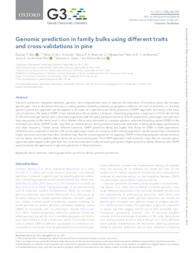Genomic prediction in family bulks using different traits and cross-validations in pine.
Genomic prediction in family bulks using different traits and cross-validations in pine.
Author(s): RIOS, E. F.; ANDRADE, M. H. M. L.; RESENDE JR, M. F. R.; KIRST, M.; RESENDE, M. D. V. de; ALMEIDA FILHO, J. O. E. de; GEZAN, S. A.; MUNOZ, P.
Summary: Genomic prediction integrates statistical, genomic, and computational tools to improve the estimation of breeding values and increase genetic gain. Due to the broad diversity in mating systems, breeding schemes, propagation methods, and unit of selection, no universal genomic prediction approach can be applied in all crops. In a genome-wide family prediction (GWFP) approach, the family is the basic unit of selection. We tested GWFP in two loblolly pine (Pinus taeda L.) datasets: a breeding population composed of 63 full-sib families (5?20 individuals per family), and a simulated population with the same pedigree structure. In both populations, phenotypic and genomic data was pooled at the family level in silico. Marker effects were estimated to compute genomic estimated breeding values (GEBV) at the individual and family (GWFP) levels. Less than six individuals per family produced inaccurate estimates of family phenotypic performance and allele frequency. Tested across different scenarios, GWFP predictive ability was higher than those for GEBV in both populations. Validation sets composed of families with similar phenotypic mean and variance as the training population yielded predictions consistently higher and more accurate than other validation sets. Results revealed potential for applying GWFP in breeding programs whose selection unit are family, and for systems where family can serve as training sets. The GWFP approach is well suited for crops that are routinely genotyped and phenotyped at the plot-level, but it can be extended to other breeding programs. Higher predictive ability obtained with GWFP would motivate the application of genomic prediction in these situations.
Publication year: 2021
Types of publication: Journal article
Unit: Embrapa Coffee
Observation
Some of Embrapa's publications are published as ePub files. To read them, use or download one of the following free software options to your computer or mobile device. Android: Google Play Books; IOS: iBooks; Windows and Linux: Calibre.
Access other publications
Access the Agricultural Research Database (BDPA) to consult Embrapa's full library collection and records.
Visit Embrapa Bookstore to purchase books and other publications sold by Embrapa.

